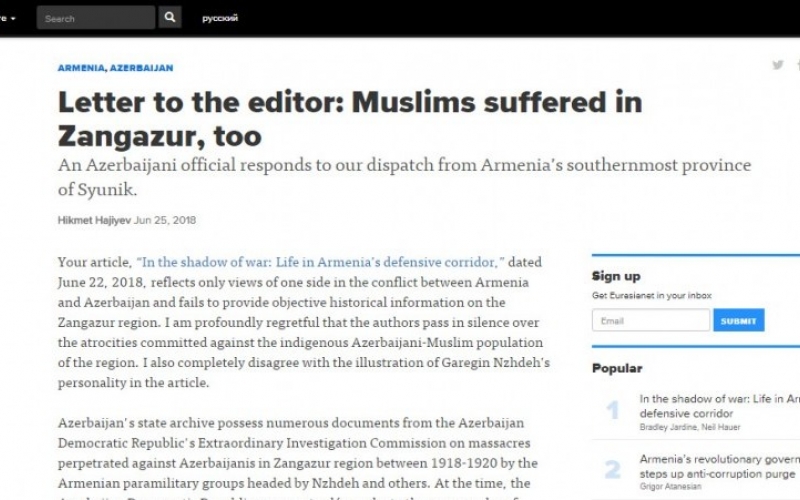
“Your article, “In the shadow of war: Life in Armenia’s defensive corridor,” dated June 22, 2018, reflects only views of one side in the conflict between Armenia and Azerbaijan and fails to provide objective historical information on the Zangazur region. I am profoundly regretful that the authors pass in silence over the atrocities committed against the indigenous Azerbaijani-Muslim population of the region. I also completely disagree with the illustration of Garegin Nzhdeh’s personality in the article,” Hajiyev writes in his letter to the editor.
“Azerbaijan's state archive possess numerous documents from the Azerbaijan Democratic Republic's Extraordinary Investigation Commission on massacres perpetrated against Azerbaijanis in Zangazur region between 1918-1920 by the Armenian paramilitary groups headed by Nzhdeh and others. At the time, the Azerbaijan Democratic Republic even sent a démarche to the commander of British Forces in the Caucasus to take actions to cease the mass murder of Azerbaijani civilians. According to the findings of the Extraordinary Investigative Commission, as a result of Nzhdeh's “scorched earth” policy, more than 10,000 Azerbaijani civilians in Zangazur region were killed and 115 Azerbaijani villages razed to the ground. The Azerbaijani populations of Goycha and Yerevan regions suffered the same tragic destiny as well”
“Due to the demographic change following the mass murder and ethnic cleansing of Azerbaijanis, the Bolsheviks rendered the Zangazur region to the Armenian Soviet Socialist Republic after their occupation of the Caucasus. The artificiality of Nakhchivan’s geographic separation from mainland Azerbaijan is more than obvious with unarmed eyes,” he says.
“During the Second World War, Nzhdeh joined the ranks of Nazi Germany and conducted the mass killing of Jews, Ukrainians, Russians and others as one of Hitler's generals. His racist and ultra-chauvinist ideology constitutes the basis of Armenia’s ex-President Serzh Sargisyan’s Republican Party,” Hajiyev says. “In the wake of USSR’s disintegration in the late '80s, a new wave of mass expulsion of Azerbaijanis from Armenia, including from Zangazur and Goycha regions started. It resulted in the establishment of the mono-ethnic state of Armenia. But that is not the end of the story. Since 1991, Armenia has unleashed a war against Azerbaijan and used force to occupy Nagorno-Karabakh and seven adjacent regions of Azerbaijan in the name of building a mythical “Greater Armenia.” More than 700,000 members of the indigenous Azerbaijani population of the occupied regions were subject to notorious ethnic cleansing”
“The authors rightly touch upon unemployment and poverty in Syunik region of Armenia. As noted in the article, this deprivation and poverty is a result of mythical “Greater Armenia” and unrealistic ambitions of territorial expansion. Unfortunately, as result of such propaganda, many people in Armenia and the diaspora live with such dreams and become hostage to the past. A fair question would be why the once-busy railroad passing through Mehri and connecting Azerbaijan/Nakhchivan with Armenia and Iran is currently closed? The reason is Armenia’s policy of territorial expansion. In order to get out the current status of self-isolation, Armenia has to cease its territorial claims on its neighbors, withdraw its troops from the occupied lands of Azerbaijan as demanded by the relevant resolutions of the UN Security Council and start to build civil relations with its neighbors. The sooner Armenia understands this reality, the better it will be for the population of Armenia, which can also benefit from the prospects of regional cooperation,” the spokesman for Azerbaijan's Ministry of Foreign Affairs concludes.
Views: 411
